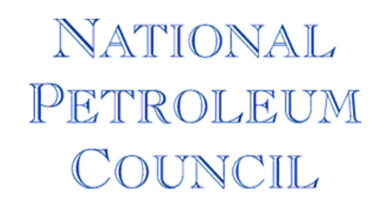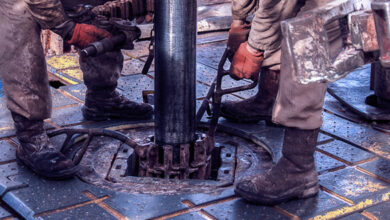Generations: Meet the Springetts: a father and son in industry
By Maggie Cox, editorial coordinator
Charlie Springett is an industry veteran who retired from Santa Fe International Corp (now Transocean) in 2002. Charlie dedicated his entire career to Santa Fe, joining in 1968 after obtaining his degree in mechanical engineering from Rugby College of Engineering Technology in the UK. He worked on platform and jackup drilling rigs in the North Sea and on Choctaw, the world’s first semisubmersible derrick/pipe lay barge, in Australia before moving to the company’s head office in California in 1971. There, he worked in engineering until his retirement as VP of engineering for the corporation.
Charlie was active in a variety of industrywide associations throughout his career, including with IADC. For many years, he chaired the Design and Equipment Subcommittee and was vice president of the Offshore Division for IADC in 1989 and ’90. He was named IADC Contractor of the Year in 1997.
His son, Frank Springett, is now vice president of engineering of the pressure control group for National Oilwell Varco (NOV), which he joined in 2001. He holds degrees in mechanical engineering and marine engineering from the California Maritime Academy (CMA), and in 2009 he earned his masters degree in technology commercialization from UT Austin.
Frank started summer roughnecking 17 years ago for Chiles Offshore in the Gulf of Mexico and Santa Fe in the North Sea. In 1996, after graduating from CMA, he was hired as division engineer for Sonat (now Transocean) and was heavily involved in the design, construction and operation of the Discoverer Enterprise.
Together, father and son share their views on the different roles played by engineers in their respective sides of the industry and discuss some of the trends emerging in technology innovation and the outlook on what’s to come.
COMPARING ENGINEERING ROLES IN THE INDUSTRY
Frank and Charlie reflect on some of the roles each has played during their careers – including the differences between an engineer working for a drilling contractor and an equipment manufacturer and the importance of management in these areas.
In Frank’s opinion, working for a drilling contractor company requires the engineer to be a jack of all trades where he has to know a little about a lot. “You have to cover a whole breadth of topics, and you have to be able to speak in an educated fashion about all of them,” he said.
Charlie agreed. This particularly applies when interacting with major oil companies, who have experts for every aspect of their business. A drilling contractor does not have that luxury. In Charlie’s day, drilling contractors were smaller (at least Santa Fe was) with smaller engineering departments. “We did not have the luxury of experts in every engineering discipline as the major oil companies do. Our engineers had to be generalists in a field of experts, and that is not always easy to do effectively,” he said.
On the other hand, Frank believes that an equipment manufacturer lives or dies by the strength of its engineering. There is no room for generalists, and engineers must have an in-depth and extensive knowledge about the equipment and processes they are working with. “You’re designing equipment, designing machinery, and you need to make sure that you’re doing that right,” he said.
Frank reflected upon his initial impression of equipment manufacturing engineers when he first started with NOV: “I thought they didn’t know what they were doing. But once I realized what goes into designing a piece of equipment, it really opened my eyes to ‘Wow, there is a lot more to this, and it’s not as easy as it seems,’ ” he said.
As VP engineering at NOV, Frank now has to deal with management issues to a much greater extent. This means interacting with people and leading them to higher levels of performance, as well as developing the management processes that allow an efficient and effective work flow. Managing instead of detailed engineering requires a different skill set but is enhanced by an underlying engineering background – a similarity he saw in his dad’s job.
THE IMPORTANCE OF GOOD MANAGEMENT
According to Frank, drilling contractor management has typically come up through the ranks working on the rigs. As a result, they are fully conversant with the operations side of the industry. Many of these management people started life as engineers. As Charlie points out, if you want to ruin a good engineer, put him in the management trainee program and make him a toolpusher. The point is the qualities that make a good toolpusher are not the qualities that make a good engineer. In contrast, Frank points out that equipment manufacturers have to find and hire people with very strong engineering- and design-based backgrounds, but they tend to lack the type of field experience that a drilling contractor can give their engineers. The perfect blend for an engineer in either organization is one with experience in both realms, he believes.
Because of the “great crew change,” the industry’s pool of engineers with long experience is shrinking; the challenge for the future, Frank and Charlie believe, will be finding new engineers to fill industry veterans’ shoes. Reinforcing the perception in the ranks of college seniors that the offshore industry is a fun and rewarding place to work is one of the most important components of this challenge. It is particularly important that the negative press the industry has received recently is counteracted by a concerted effort by industry professionals, as well as organizations like IADC, through an effective public relations campaign. The industry has a great deal to be proud of and an outstanding safety record, notwithstanding the events of this summer. This record should convince any thinking person that the United States’ long-term energy interests are best served by an aggressive and focused oilfield development program onshore, as well as in the full range of water depths accessible to our drillers.
“There is no doubt that our universities and colleges are producing quality engineering graduates. Our challenge,” Frank said, “is to motivate these graduates to get their hands dirty for a few years so they can join the design workforce with the right mix of education and hands-on experience. I think the real go-getters and stars are going to be those that are willing to accept that challenge.”
INNOVATION, TECHNOLOGY
The offshore drilling industry has seen enormous change and evolution since Charlie’s days on Southern North Sea platform rigs. He recalls dismantling a derrick with a few men and a Land Rover, and a jackup production platform operating in the Norwegian sector with a wooden helideck (he doesn’t think that would pass NPD scrutiny today).
Some of the evolution has been driven by the need to develop new equipment and procedures to meet new challenges, and some has been driven by regulations resulting from major accidents that caused the industry to step back and say, “How do we make sure this does not happen again?” Sea Gem in 1965, Ocean Prince in 1968, Alexander Kielland in 1980, Ocean Ranger in 1982 and Piper Alpha in 1988 are all examples of disasters that spawned new regulations. In every case, industry engineers came together, usually with IADC support, to help make sure that new regulations address the real problems and won’t do lasting harm to the greater industry – not always an easy task. Charlie believes that this is one of the most important responsibilities IADC has. It is not easy to extract busy engineers from their daily duties, but if we are to maintain an effective voice in the greater community, they must be extracted, and IADC is the best vehicle for doing so.
Current examples of IADC’s role are the IADC Advanced Rig Technology (ART) Committee and the ART Future Technology Subcommittee. Frank is heavily involved in both of these initiatives, whose goal is to educate the industry on methods of successfully introducing and adopting new technology.
These committees have focused on helping the industry to accept and adopt a higher level of automation. “We’ve targeted the oil companies, and they are starting to see the value of closing the loop on drilling controls from surface to bit,” Frank said. “I think we’re a lot closer now because of the way IADC and SPE have really attacked the problem to try and get everyone on the same page.”
“The key to innovation is finding the core problem. It’s about generating value for the end user, and that’s probably where we’ve fallen short on projects that weren’t successful,” Frank said.
Charlie agreed. “The industry has always been absolutely schizophrenic about new technology. The industry tends to be very resistant to change while at the same time, in my 40 years, it has developed and adopted an astonishing range of new equipment and technology.”
He continued, “The difference today is that anything new must be backed up by sound and rigorous engineering. In the past, industry was much more prepared to experiment. Today, for example, we tend to take jackups for granted (and go to extraordinary lengths to analyze their performance in offshore weather conditions), but if there were no jackups in the industry today and someone came along and proposed one, I am sure the response would be ‘No, we can’t do that because we can’t make the engineering work.’ ”
In Charlie’s opinion, the industry has come as far as it has in part because well-run companies have been prepared to take the risks associated with making major capital investments in equipment. Those risks have been mitigated, to some extent, by quality engineering, as well as one of the most dedicated and well-trained work forces in the world. Along the way, the industry has homed in on technologies that are the most economical and efficient, which is why modern jackups today all look pretty much the same, as do deepwater semisubmersibles, he said.
IADC & INDUSTRY OUTLOOK
Both technology and the offshore drilling industry continue to change. Charlie and Frank believe that an association like IADC has a very important role to play in managing that change.
“IADC has done some really outstanding work in the past in addressing regulatory challenges,” Charlie said. “It has been a constant throughout my career, and they have helped the drilling contractors address those challenges in a way that satisfies the need to make things safer and better, and yet that does not hamstring this industry with unnecessary, cumbersome and expensive regulation. The need to continue this effort has never been greater given the very unfortunate events of this summer.”
Both Frank and Charlie hope that industry associations, particularly IADC, will continue to lobby on behalf of the industry with government and regulators. But lobbying is not enough. The industry should insist on seats at the table when new regulations are discussed, and those seats should be filled by the best drilling contractor engineers we can find. IADC’s highest calling is making sure our companies are represented at these meetings.
Charlie and Frank are also positive that industry associations can do a better job of getting more information to the public about the industry and the many dedicated and talented people who comprise it. “Where I live in Virginia, there is an appalling ignorance of what offshore drilling entails and what the industry is capable of,” Charlie said, “although they have certainly received an education during these last three months. We should build on that education because the story we have to tell is both powerful and interesting and ultimately says volumes about what this country can do. It is a story most people want to hear.”








I do not agree with Charlie Springett. A toolpusher with an engineering background is far better prepared for a career in the international oil and gas industry than a toolpusher with only practical training and an engineer who cannot drill and complete oil and gas wells.